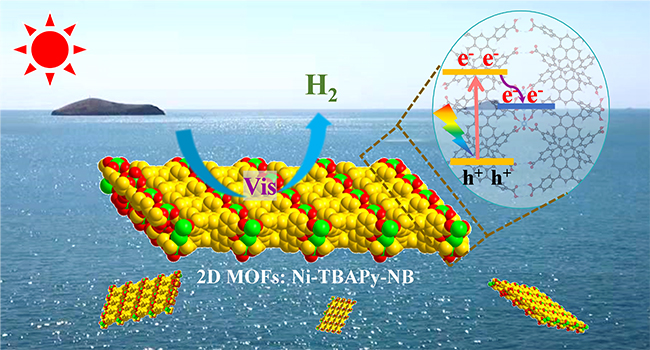Novel Wide Visible-light-responsive MOFs Photocatalysts Boost Water Splitting to Produce Hydrogen
Photocatalytic water splitting to produce green hydrogen is one of the ideal ways to convert solar energy into chemical energy. However, it still remains challenge to develop efficient photocatalysts with a wide range of visible-light absorption for this process.

Schematic photocatalytic water splitting into hydrogen of Ni-TBAPy-NB(Image by LIU Lifang)
Recently, a research group led by Prof. ZHANG Fuxiang from the Dalian Institute of Chemical Physics (DICP) of the Chinese Academy of Sciences developed a novel wide visible-light-responsive Ni-MOFs photocatalyst which could boost water splitting to produce hydrogen under visible-light irradiation.
This study was published in Journal of the American Chemical Society on Feb. 2.
The researchers uniformly integrated 1,3,6,8-tetrakis(p-benzoic acid)pyrene (H4TBAPy) ligand as light-harvesting center and [Ni3O16] nickel-oxide cluster as catalytic center into the MOFs single crystal framework, then subsequently exfoliated it into 2D Ni-TBAPy-NB nanobelts.
Benefitted from special 2D nanobelts, the ordered coordination structure and special frameworks structure contained light-harvesting center and catalytic site of the nanobelts, leading to high charge separation efficiency and water reduction activity on nanobelts. The apparent quantum efficiency (AQE) of photocatalytic water splitting to produce hydrogen reached 8.0% (420 ± 10 nm excitation).
"These results provide a reference for the design and synthesis of other high-efficiency MOF-based photocatalytic materials for efficient solar-to-chemical energy conversion," said Prof. ZHANG.
This study was supported by the National Natural Science Foundation of China, International Partnership Program of Chinese Academy of Sciences, the National Key Research and Development Program of China. (Text by LIU Lifang)